
Equipment
Truck Checks: Transmission Tips – Part 3
While the family of older hydraulic-mechanical Allison transmissions (AT-MT-HT) was very good for the fire service, the world transmission called the WT and the newer Emergency Vehicle Service transmission (EVS) are excellent for our use. There are a number of reasons for this.
June 6, 2008
By Don Henry
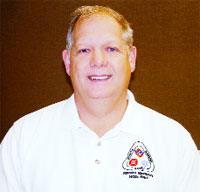 While the family of older hydraulic-mechanical Allison transmissions (AT-MT-HT) was very good for the fire service, the world transmission called the WT and the newer Emergency Vehicle Service transmission (EVS) are excellent for our use. There are a number of reasons for this.
While the family of older hydraulic-mechanical Allison transmissions (AT-MT-HT) was very good for the fire service, the world transmission called the WT and the newer Emergency Vehicle Service transmission (EVS) are excellent for our use. There are a number of reasons for this.
■ ADAPTIVE LEARNING
The WT and the newer EVS have a quality called adaptive learning. This feature allows the transmission to change over time to meet the needs of the user. All transmission components, such as clutches, experience normal wear over time. These clutches could slip when engaging during full power up-shifts. The Allison’s computer can measure the speeds of the input shafts, the clutches, the output shaft and the position of the foot pedal. It can then take all this information and command the clutches to apply. By making sure the clutches do not have excessive slip during engagement, the clutch facings will not overheat because of friction. These full-power shifts will be very firm to ensure long clutch life. This transmission can also give very smooth shifts under light acceleration. In fact, the shift quality can rival that of many automotive high-end cars. You would not have to drive a piece of older fire apparatus with a HT 740 transmission very far to appreciate the improved shift quality that this new electronic transmission can provide. This transmission, because of its adaptive learning, can even adapt to different drivers. If your people are the pedal-to-the metal type, with long-up hill grades the transmission will learn to make harder, firmer shifts. If your department does not have the need for such aggressive driving, the transmission will learn to make softer, smoother shifts.
The transmission’s computer comes programmed from the factory with hard, firm shifts. Its computer called an ECU (electronic control unit) quickly learns to adapt to the needs to the user. If, for any reason, the transmission loses electrical power, for example, if the batteries go dead, the transmission will revert to the harsher factory setting. This is not bad; it will just take a few hours of normal use to relearn.
To ensure that the computer never loses its memory in the event of a power loss many departments installed an extra battery. This was called an isolation battery. Its job was to keep the transmission, and, in some cases, the electronic engine, operating in the event of a complete power loss. This could happen if a main starting battery cells became defective or an alternator was failed while at a fire scene. This idea was thought to be the solution to keeping the computer alive until the isolation batteries began to fail over time. Even if the main batteries were good, if the computer saw fewer than 10 volts, the engine and/or transmission would ether not run or would run poorly.
This isolation battery was often not located in the normal battery box but hidden close to the transmission. The old saying, out of sight, out of mind, applied here. Only a trained EVT who knew what this battery was for would even think to look for it. As such, many of these isolation batteries were neglected and, over time, failed. These failures caused a lot of problems. As such, it is not recommend that an isolation battery be used.
Even if you turn off the main batteries with a master disconnect switch, you do not cut the power to the transmission computer – its memories have to keep alive with battery power. It the master disconnect switch did cut power to the computer each time you turned it off, then the transmission would always revert back to the harsher factory shifts. There have been reports of this happing to fire apparatus. (See photo 1.)
It is now more common to find load-shedding devices that will shut off electrical loads to ensure that the computers on the fire apparatus receive the required voltages. We will address this in a future column.
 |
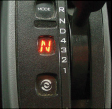
|
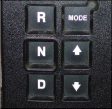
|
||
| PHOTO 1 Master disconnect switch.
|
PHOTO 2 On this lever model, push the Allison symbol button in the lower left hand side. |
PHOTO 3 Shift pad: On this model, push the up and down buttons at the same time.
|
||
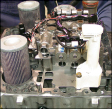 |
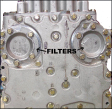 |
|||
| PHOTO 4 Valve body removed, optional oil level sensor in lower right hand corner (white), note oil filters right side of picture.
|
PHOTO 5 Oil filter locations, looking up from below.
|
■ TRANSMISSION CODES
As with any mechanical device, things will go wrong, but the Allison has some neat diagnostic tricks to help keep you going.
The computer has the ability to talk to you and tell you what is wrong.If a problem were to happen when operating the transmission, the computer could set a diagnostic code. If the code is not serious and does not happen again, then the code will disappear after 25 engine starts. If the problem is serious and is persistent then the transmission warning light will illuminate on the dash. This is also called the Do Not Shift (DNS) light. I have often told my students that it really could be called the Will Not Shift light. For example. if the rear output shaft speed sensor were to disconnect from its wire, then the transmission would set a code. The transmission would coast until you obtained first range and then the transmission would stay in first range.
Just for reference, Allison does not call it first gear, second gear and so on, rather it call uses first range, second range, etc. You can do what you want – shift to neutral, reverse, even shut off the truck and restart – you are still in first range.
The term for this code is called a hard code. You will have to fix the problem and then drive the truck. When the computer now sees the speed sensor is connected, then this code will become a soft code You may also hear it called an historic code. You can then erase the code or simply do nothing and the code will disappear after 25 starts.
Does it cost a lot for diagnostic computers and training to extract these codes? No. In fact, Allison has made it very simple for you to obtain the codes from the computer. Depending on the generation or model, different methods are used. First, turn off the engine and move the start key to the run position. If you have a transmission console with the up and down arrow keys, push these keys at the same time. (See photo 2.)
If you have the shift lever (very popular with fire departments because it can be used with gloves on, then push the display button once. (See photo 3.) This button looks like the Allison symbol.
The computer can hold up to five diagnostic codes and it will read out the D1 (diagnostic one) code first. The lights will flash a D1 and then the two-digit main code and a two-digit sub code. You can then write down the codes and refer to the manuals.
For example, a code D1-21-12 indicates that this is main code 21 and indicates a problem with the throttle position sensor signal (that’s the foot pedal for the rest of us) and sub code of 12 indicates that the throttle position sensor signal was low. This could be just a badly corroded connection. That’s a pretty smart computer but it can not tell you that maybe you are just washing the under hood of the truck to much and have repeatedly sprayed some high-pressure hot, soapy water into the connections.
If there are other codes you will need to write them down and fix the problems as you go. If you think there are other codes, push the mode button to retrieve the remaining codes.
It is rare to have a problem on this transmission but if you have to do troubleshooting it is made much easier with the use of diagnostic codes.
Even though I teach this, have I memorized all the codes? Of course not. They made books for that! Go to your local Allison deal and ask for the book that has the codes for your transmission or go to www.allisontransmission.com. There are also some great videos at this site that you can watch on the subject of transmission codes. While you are there, look up your local dealer and see if it offers any courses.
We are very lucky in Alberta to have two Allison training schools, one in Edmonton and one in a smaller city to the south of Edmonton that also has a hockey team. I am talking about Waterous power systems: look up www.waterouspower.com – it offers excellent courses for both the operator (firefighter) and the technician.
It has been my experience that very little goes wrong with the transmission. When problems do occur they are usually caused by incorrectly installed two-way radio transmitters that people that think they can weld on the fire truck without first disconnecting the computers or not using genuine Allison parts.
■ OIL LEVEL AND FILTERS
All the information on oil-level checks in the May issue of Fire Fighting in Canada that apply to the At-Mt-Ht also apply to the WT and I will not repeat them here.
The WT has a few features that need to be explained. The first is an optional oil-level checking system. This allows you to electronically check the oil level from the seat of the truck. If the oil level dipstick was not correctly wiped off and installed back into the transmission correctly, there is a good chance that dirt could be put into the transmission. This oil-level option removes the chance of this happening.
There are a few things to learn before you use this feature. First, the transmission must be warned up, the truck level and the engine at idle. You use the same buttons as you used to check for engine codes. If the transmission has the oil-level sensor option then the first push of the button will tell you oil level. The button will have to be pushed again for transmission codes. It may take a few seconds after you push the button for the level sensor to give you a reading. If the display reads OL-OK-OK then the oil level is OK to go. The sensor can read as much as four quarts low or high.
For example, if you were six quarts low, then you would read only four quarts low. This can be a handy feature for fire apparatus as often it can be difficult to access the transmission oil level dipstick on custom cabs. I would still ask for a monthly visual check of the dipstick to ascertain oil condition. (See photo 4.)
There are two transmission oil filters. One for lubrication and the other a main oil filter. They are easier to access than the older MT transmission as you do not have to remove the oil pan to change them. I recommend only the genuine Allison filters. Change them on schedule and use an oil analysis program. This is not a place to save a few dollars on an off-brand filter. (See photo 5.)
We will continue our look at transmissions in the August issue.
Don Henry teaches in the Automotive Service Technician and Heavy Equipment Technician programs at Lakeland College in Vermilion, Alta., where he has been a faculty member for more than 17 years. He has co-developed and delivers Canada’s only post-secondary level fire apparatus maintenance program and has completed a textbook on fire apparatus.
Print this page